

CN Tower
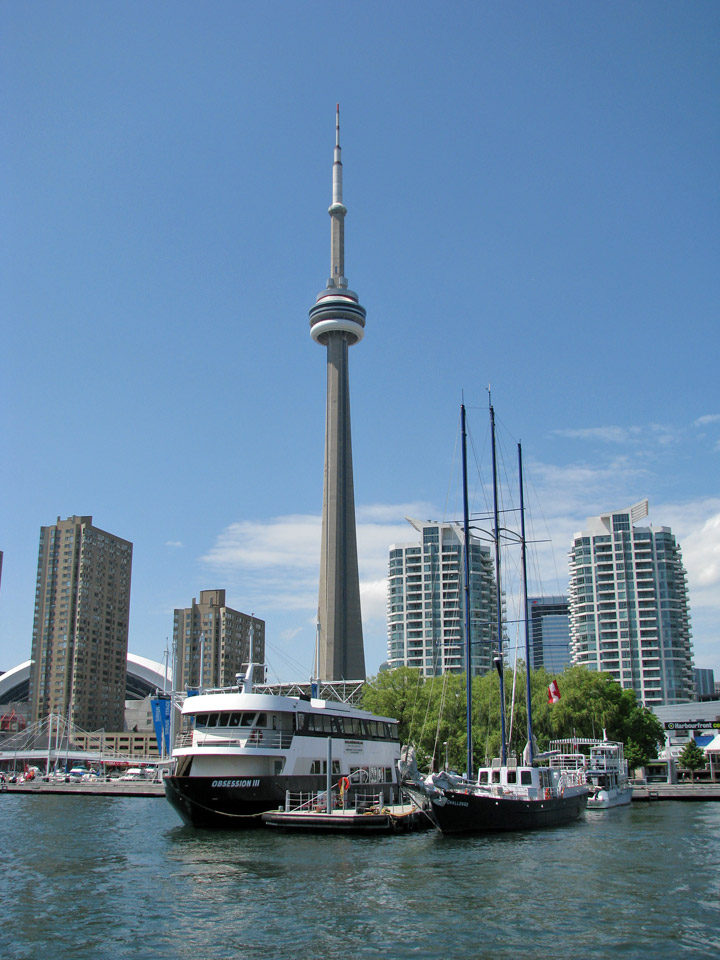
CN Tower
The CN Tower, located in downtown
Toronto, Ontario, Canada, is a communications and tourist tower standing 553.33
metres (1,815.39 ft) tall. It surpassed the height of the Ostankino Tower
while still under construction in 1975, becoming the tallest free-standing
structure on land in the world. On September 12, 2007, after holding the record
for 31 years, the CN tower was surpassed in height by the
still-under-construction Burj Dubai. It remains the tallest free-standing
structure in the Americas and the signature icon of Toronto's skyline,
attracting more than two million international visitors annually.
CN originally referred to Canadian National, the railway company that built the
tower. Following the railway's decision to divest non-core freight railway
assets, prior to the company's privatization in 1995 it transferred the tower to
the Canada Lands Company, a federal Crown corporation responsible for real
estate development. Since local residents wished to retain the name CN Tower,
the abbreviation is now said to expand to Canada's National Tower rather than
the original Canadian National Tower; however, neither of these are commonly
used.
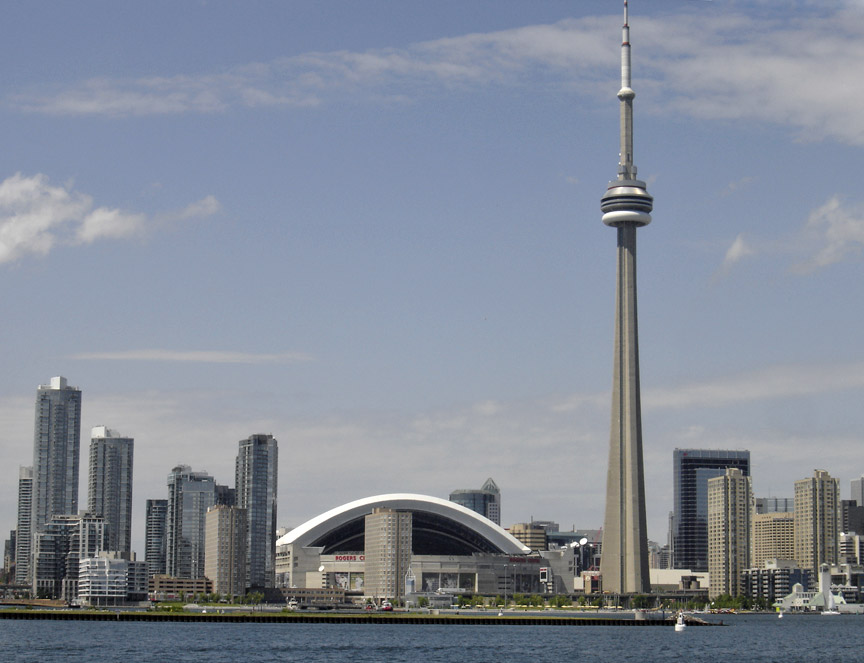
In 1995, the CN Tower was declared one of the modern Seven Wonders of the World
by the American Society of Civil Engineers. It also belongs to the World
Federation of Great Towers.
The concept of the CN Tower originated from a 1968 Canadian National Railway
desire to build a large TV and radio communication platform to serve the Toronto
area, as well as demonstrate the strength of Canadian industry and CN in
particular. These plans evolved over the next few years, and the project became
official in 1972. The tower would have been part of Metro Centre,
a large development south of Front Street on the Railway Lands, a large railway
switching yard that was being made redundant by newer yards outside the city.
Key project team members were NCK Engineering as structural engineer; John
Andrews Architects; Webb, Zerafa, Menkes, Housden Architects; Foundation
Building Construction; and Canron (Eastern Structural Division).
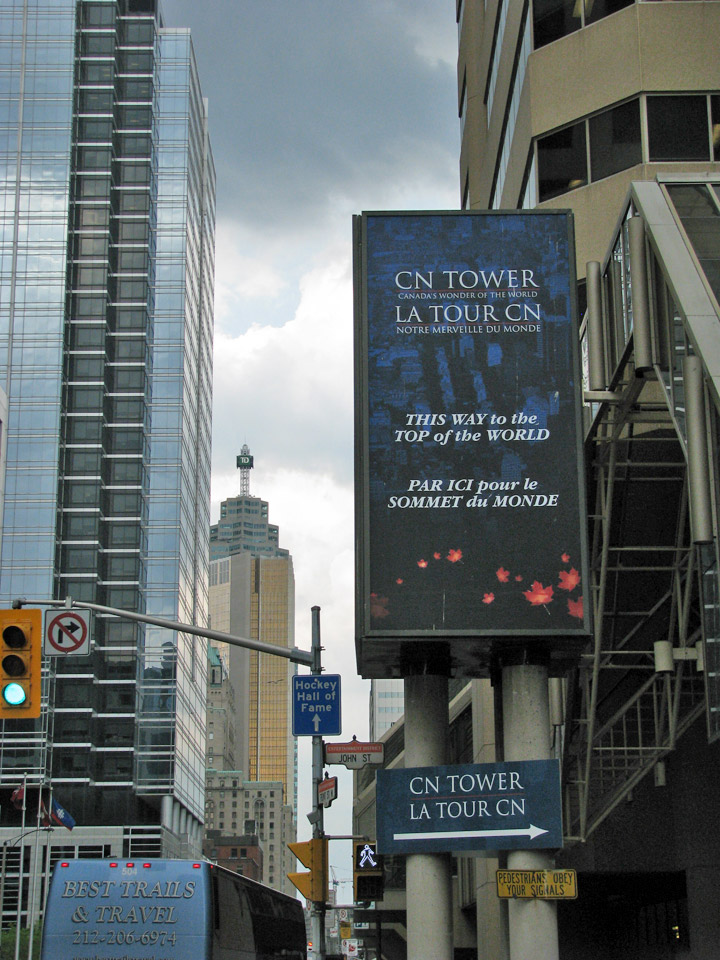
entrance for CN Tower tours
At the time, Toronto was a boom town, and the late 1960s and early 1970s had
seen the construction of numerous large skyscrapers in the downtown core. This
made broadcasting into the downtown area very difficult due to reflections off
the buildings. The only solution would be to raise the antennas above the
buildings, demanding a tower over 300 meters (984 ft) tall. Additionally, at the
time, most data communications took place over point-to-point microwave links,
whose dish antennae covered the roofs of large buildings. As each new skyscraper
was added to the downtown, former line-of-sight links were no longer possible.
CN intended to rent "hub" space for microwave links, visible from almost any
building in the Toronto area. The CN Tower can be seen from at least as far away
as Gamble Street in Richmond Hill, Ontario, approximately 30 kilometers (19 mi)
to the north, and from several points on the south shore of Lake Ontario, 48
kilometers (30 mi) to the south.
The original plan for the tower envisioned a tripod consisting of three
independent cylindrical "pillars" linked at various heights by structural
bridges. Had it been built, this design would have been considerably shorter,
with the metal antenna located roughly where the concrete section between the
main level and the Sky Pod lies today. As the design effort continued, it
evolved into the current design with a single continuous hexagonal core to the
Sky Pod, with three support legs blended into the hexagon below the main level,
forming a large Y-shape structure at the ground level.
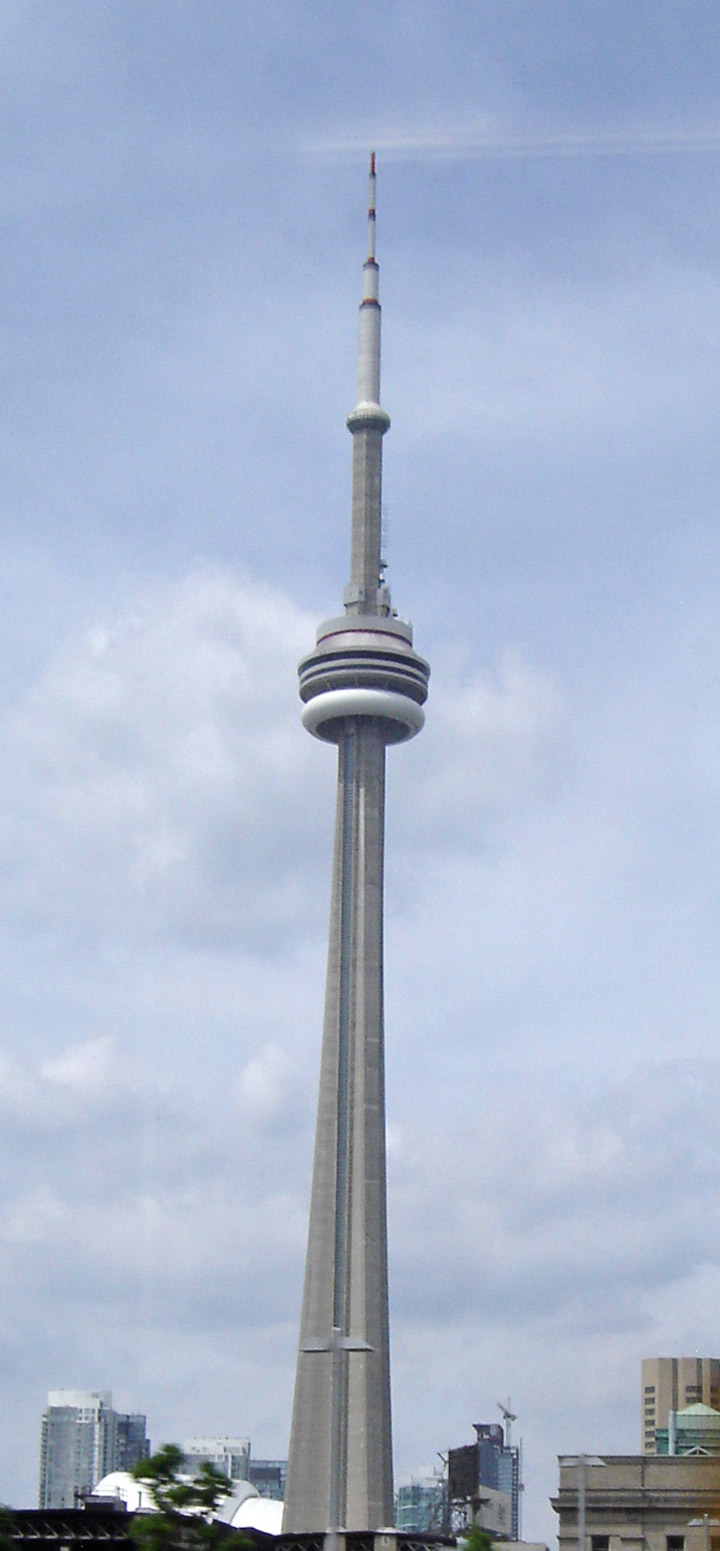
The idea for the main level in its current form evolved around this time, but
the Sky Pod was not part of the plans until some time later. One engineer in
particular felt that visitors would feel the higher observation deck would be
worth paying extra for, and the costs in terms of construction were not
prohibitive. It was also some time around this point that it was realized that
the tower could become the world's tallest structure, and plans were changed to
incorporate subtle modifications throughout the structure to this end.
Construction on the CN Tower began on February 6, 1973 with massive excavations
at the tower base for the foundation. By the time the foundation was complete,
56,000 tonnes (61,729 ST) of dirt and shale were removed to a depth of 15 meters
(49.2 ft) in the centre, and a base incorporating 7,000 cubic metres (9,156 cu
yd) of concrete with 450 tonnes (496 ST) of rebar and 36 tonnes (40 ST) of steel
cable had been built to a thickness of 6.7 meters (22 ft). This portion of the
construction was fairly rapid, with only four months needed between the start
and the foundation being ready for construction on top.
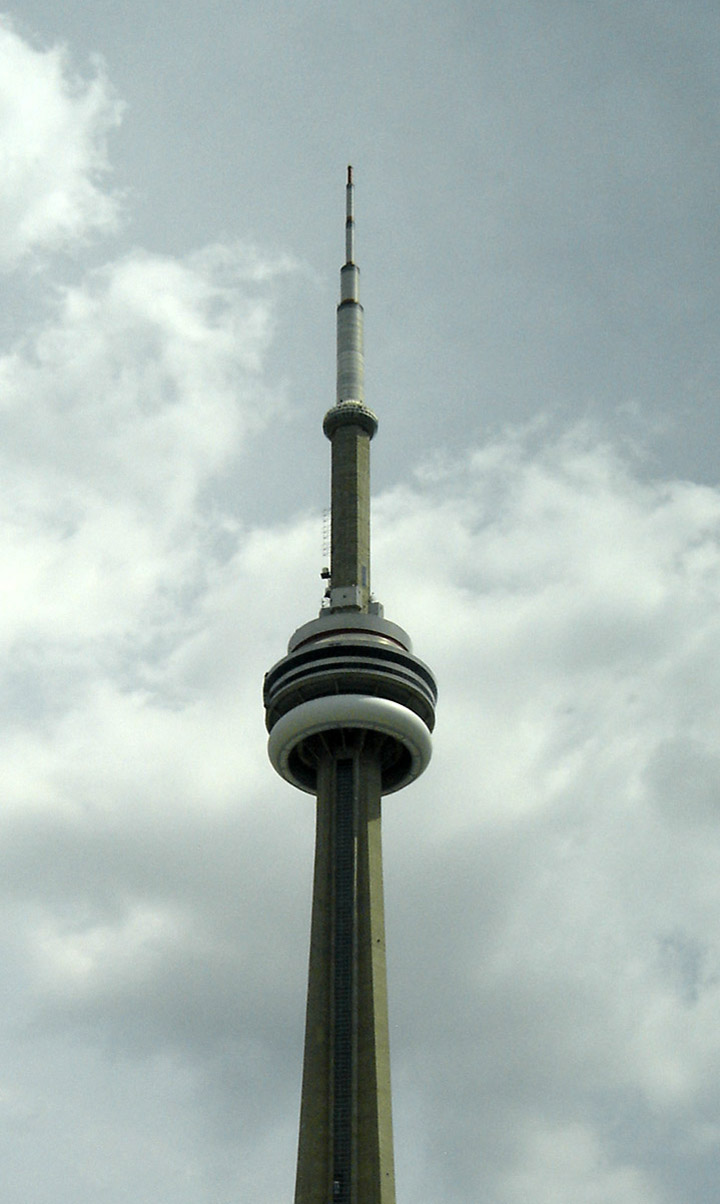
To build the main support pillar, a hydraulically-raised slipform was built at
the base. This was a fairly impressive engineering feat on its own, consisting
of a large metal platform that raised itself on jacks at about 6 meters (19.7
ft) per day as the concrete below set. Concrete was poured continuously by a
team of 1,532 people until February 22, 1974, during which it had already become
the tallest structure in Canada, surpassing the recently built Inco Superstack,
which was built using similar methods. In total, the tower contains 40,500 cubic
meters (52,972 cu yd) of concrete, all of which was mixed on-site in order to
ensure batch consistency. Through the pour, the vertical accuracy of the tower
was maintained by comparing the slip form's location to massive plumb-bobs
hanging from it, observed by small telescopes from the ground. Over the height
of the tower, it varies from true vertical accuracy by only 29 millimeters (1.1
in).
In August 1974, construction of the main level commenced. Using 45 hydraulic
jacks attached to cables strung from a temporary steel crown anchored to the top
of the tower, twelve giant steel and wooden bracket forms were slowly raised,
ultimately taking about a week to crawl up to their final position. These forms
were used to create the brackets that support the main level, as well as a base
for the construction of the main level itself. The Sky Pod was built of concrete
poured into a wooden frame attached to rebar at the lower level deck, and then
reinforced with a large steel compression band around the outside.
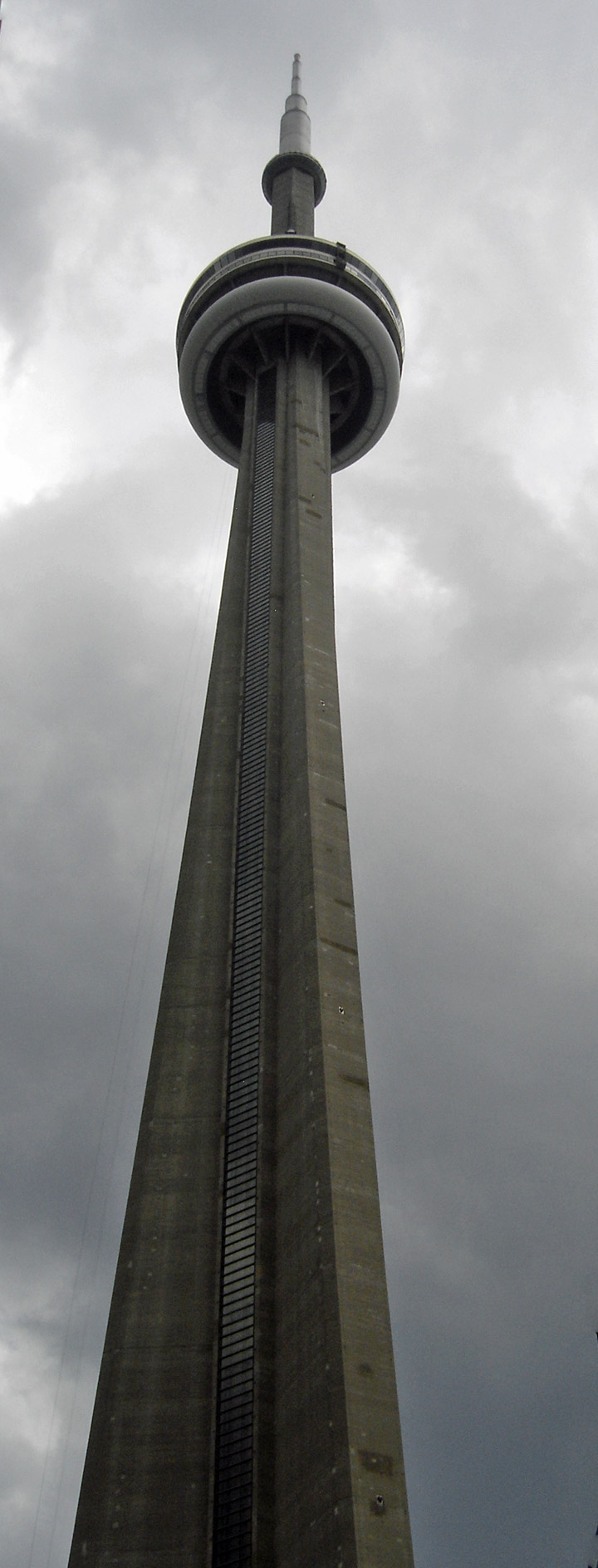
The antenna was originally to be raised by crane as well, but during
construction the Sikorsky S-64 Skycrane helicopter became available when the
United States Army sold off theirs to civilian operators. The helicopter, named
"Olga", was first used to remove the crane, and then flew the antenna up in 36
sections. The flights of the antenna pieces were a minor tourist attraction of
their own, and the schedule was printed in the local newspapers. Use of the
helicopter saved months of construction time, with this phase taking only three
and a half weeks instead of the planned six months. The tower was topped off on
April 2, 1975 after 26 months of construction, officially capturing the height
record from Moscow's Ostankino Tower, and bringing the total mass to 118,000
tones (130,073 tons).
Two years into the construction, plans for Metro Centre were scrapped, leaving
the tower isolated on the Railway Lands in what was then a largely abandoned
light-industrial space. This caused serious problems for tourists to access the
tower. Ned Baldwin, project architect with John Andrews, wrote at the time that
"All of the logic which dictated the design of the lower accommodation has been
upset," and that "Under such ludicrous circumstances Canadian National would
hardly have chosen this location to build."
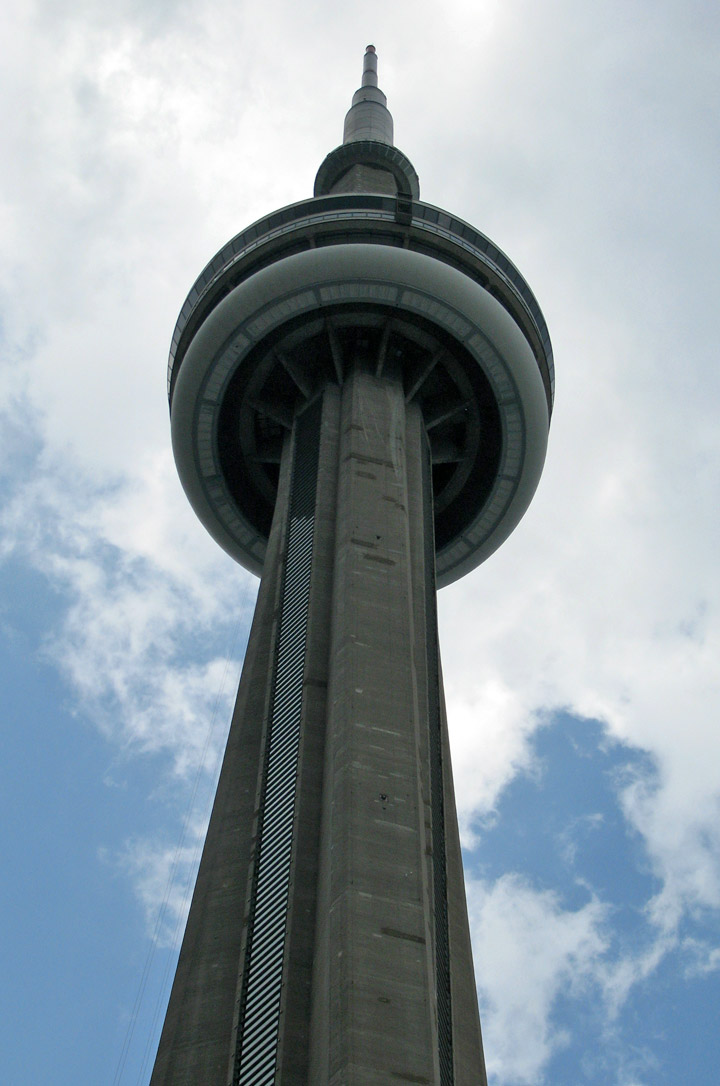
The CN Tower opened to the public on June 26, 1976, although the official
opening date was October 1. The construction costs of approximately CDN$63
million ($330 million in 2005) were repaid in fifteen years. Canadian National
Railway sold the tower prior to taking the company public in 1995, when they
decided to divest themselves of all operations not directly related to their
core freight shipping businesses.
As the area around the tower was developed, particularly with the introduction
of the Metro Toronto Convention Centre and Rogers Centre (known as the SkyDome
before 2005), the former railway "wasteland" disappeared and the tower became
the centre of a newly developing entertainment area. Access was greatly improved
with the construction of the SkyWalk in 1989, which connected the tower and
SkyDome to the nearby railway and subway station, Union Station. By the
mid-1990s, it was the centre of a thriving tourist district. The entire area
continues to be an area of intense building, notably a boom in condominium
construction in the 2000s.
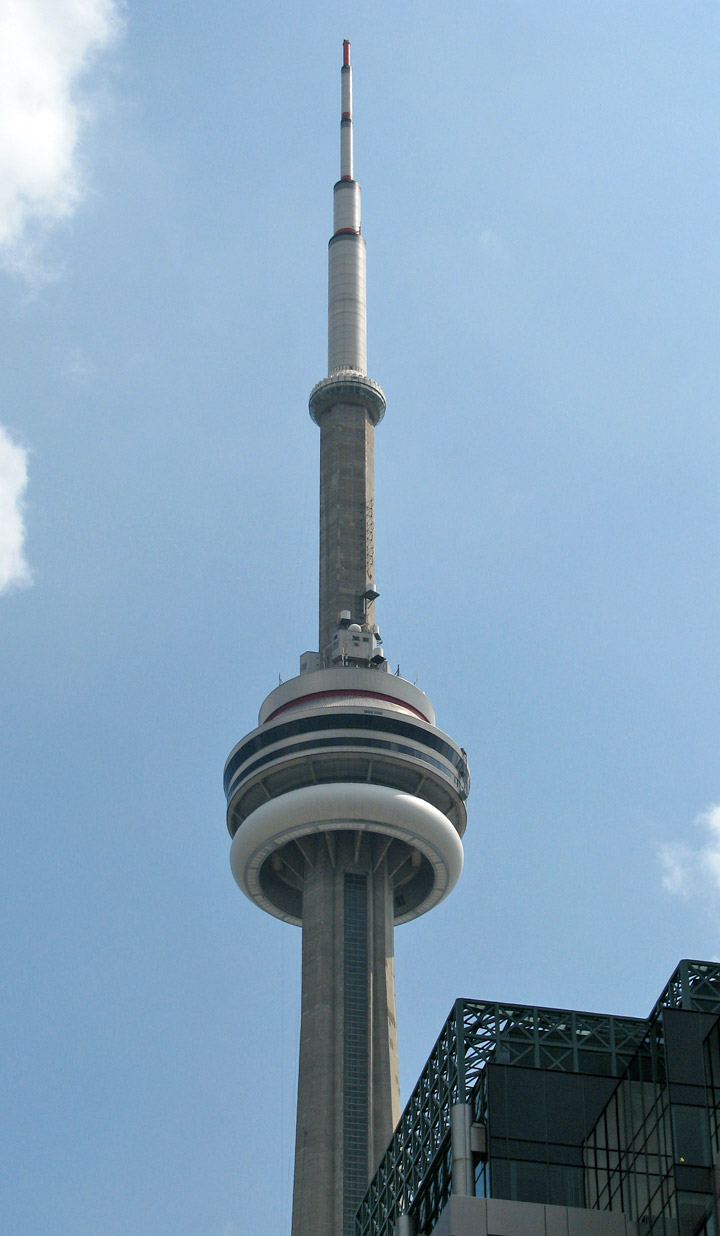
From 1997 to January 2004, TrizecHahn Corporation managed the building and
instituted several expansion projects including a $26 million entertainment
expansion and revitalization that included the addition of two new elevators (to
a total of six) and the relocation of the staircase from the north side leg to
inside the core of the building, a conversion that also added nine stairs to the
climb.
The CN Tower consists of several substructures. The main portion of the tower is
a hollow concrete hexagonal pillar containing the six elevators, stairwells, and
power and plumbing connections. On top of this is a 102 meters (334.6 ft) metal
broadcast antenna, carrying TV and radio signals. There are two visitor areas:
the main deck level (formerly known as SkyPod) located at 346 meters (1,135 ft),
and the higher Sky Pod (formerly known as "Space Deck) at 446.5 meters (1,465
ft), just below the metal antenna. The hexagonal shape can be seen between
the two areas; however, below the main deck, three large supporting legs give
the tower the appearance of a large tripod.
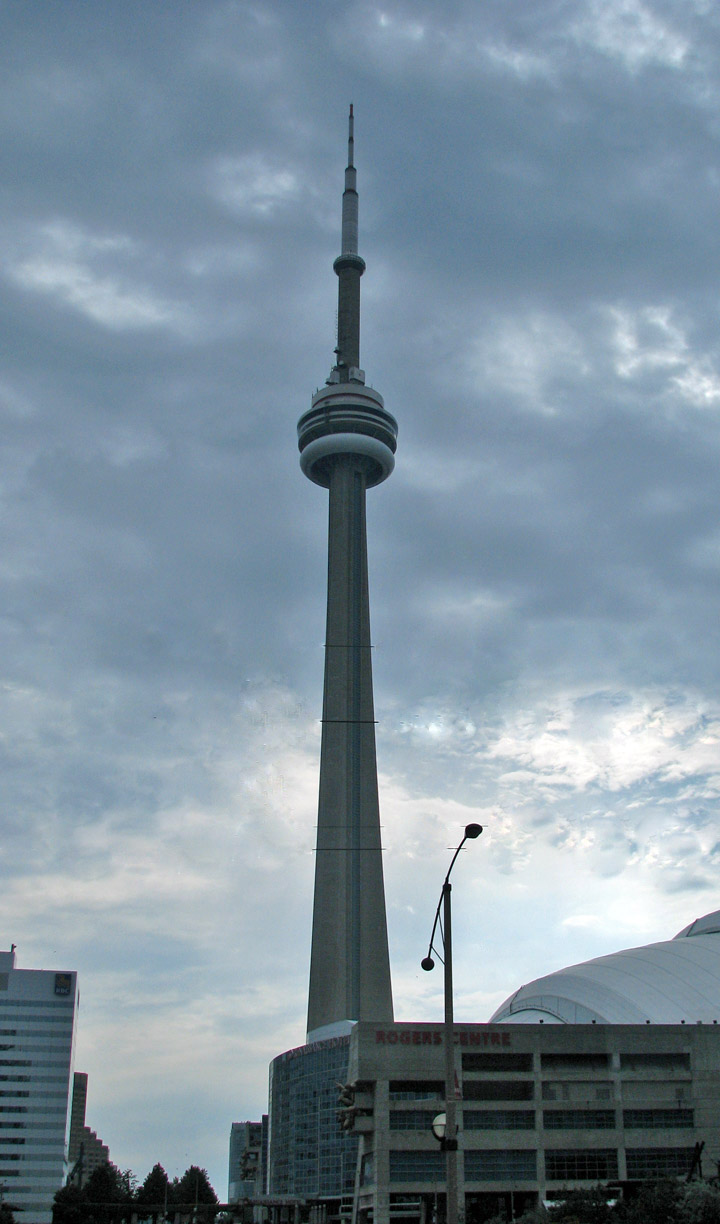
The main level is seven stories, some of which are open to the public. Below the
public areas — at 338 meters (1,108.9 ft) — is a large white donut-shaped radome
containing the structure's microwave receivers. The glass floor and outdoor
observation deck are at 342 meters (1,122.0 ft). The glass floor has an area of
24 square meters (258 sq ft) and can withstand a pressure of 4,100 kilopascals
(595 psi). The floor's thermal glass units are 64 millimeters (2.5 in) thick,
consisting of a pane of 25-millimetre (1.0 in) laminated glass, 25 millimeters
(1.0 in) airspace and a pane of 13-millimetre (0.5 in) laminated glass. Some
people experience acrophobia when standing on the glass floor and looking down
at the ground 342 meters (1,122.0 ft) below. In 2008, one elevator was upgraded
to add a glass floor panel, believed to have the highest vertical rise of any
elevator so equipped. The Horizons Cafe and the lookout level are at 346
meters (1,135.2 ft). The 360 Restaurant, a revolving restaurant that completes a
full rotation once every 72 minutes, is at 351 meters (1,151.6 ft). When the
tower first opened, it also featured a disco named Sparkles, billed as the
highest disco and dance floor in the world.
The Sky Pod is the highest public observation deck in the world. On a clear day, it is possible to see 100 to 120 kilometers (62–75 mi)
away, to the city of Rochester across Lake Ontario in the United States, the
mist rising from Niagara Falls, or the shores of Lake Simcoe.
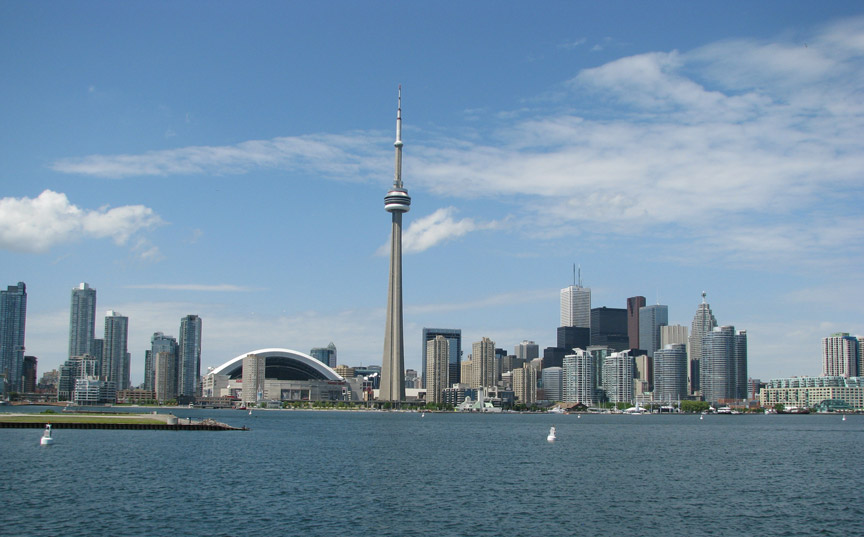
Toronto skyline
A metal staircase reaches the main deck level after 1,776 steps, and the Sky Pod 100 meters above after 2,579 steps; it is the tallest metal staircase on Earth. These stairs are intended for emergency use only and are not open to the public, except for three times per year for charity stair-climb events. The average climber takes approximately 30 minutes to climb to the base of the radome, but the fastest climb on record is 7 minutes and 52 seconds in 1989 by Brendan Keenoy, an Ontario Provincial Police Officer. In 2002, Canadian Olympian and Paralympic champion Jeff Adams climbed the stairs of the tower in a specially designed wheelchair.
Text from Wikipedia